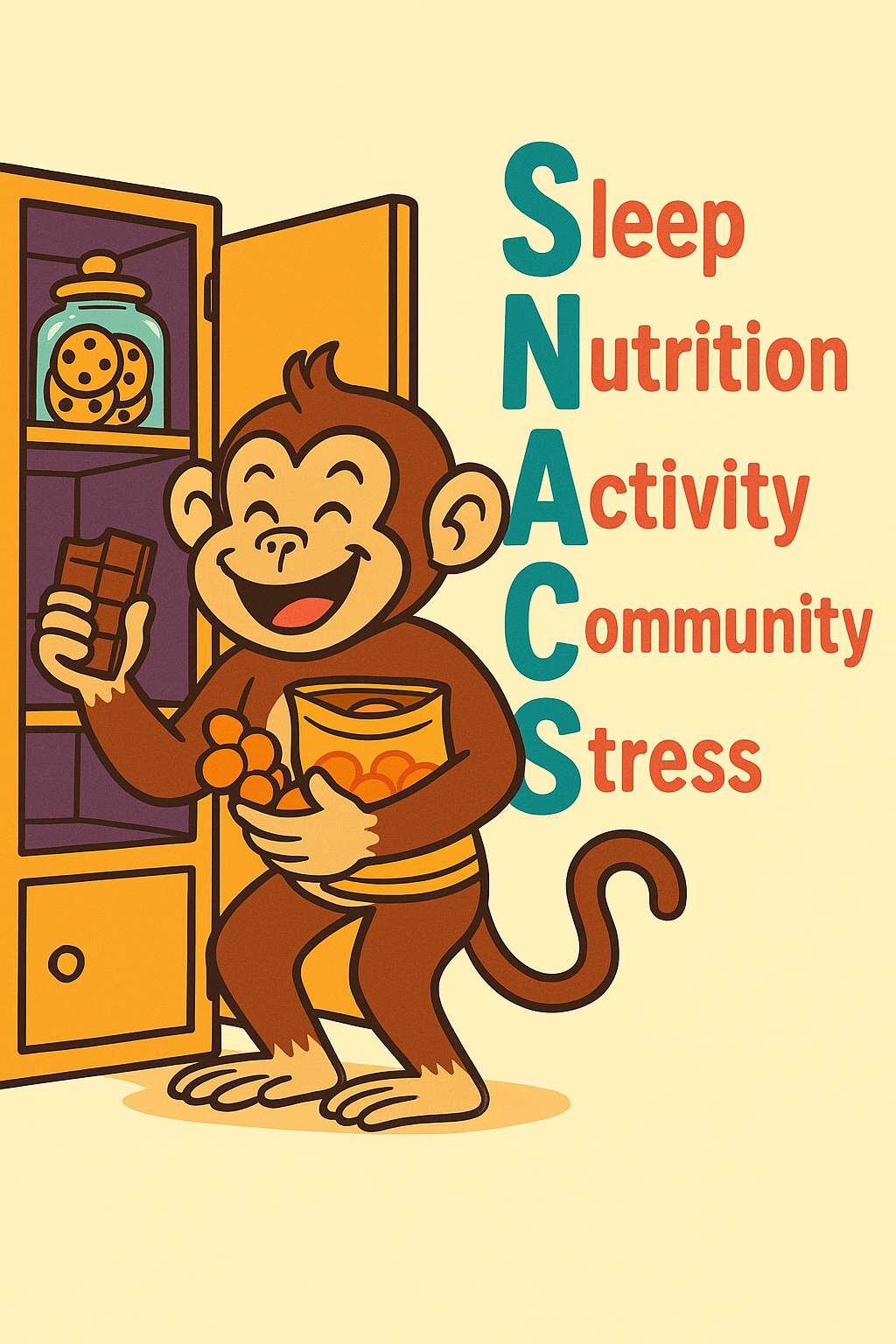Master Your Menopause in 5 Simple Steps – Using the SNACS Formula
Managing your Menopause Monkey!
The 2025 theme for World Menopause Month is Lifestyle Medicine.
At Imagine How, we believe lifestyle choices are one of the most powerful tools you have during menopause, but they work best when they are tailored to you.
That is why, in our Menopause Blueprint, the Tailor pillar helps you build a personalised mastery plan.
One of the simplest tools I teach is SNACS - it is easy to remember, and it focuses on five evidence-based lifestyle areas that influence how you feel in midlife.
It also helps you spot when your Menopause Monkey - that mischievous inner voice that tries to lead you off track when your hormones are fluctuating - is getting the upper hand.
Here is the science behind each of the SNACS, and how your Menopause Monkey might show up.
1. Sleep – Foundation for Brain and Body Health
Menopause can disrupt sleep through hot flushes, night sweats, and changes in oestrogen, progesterone, and melatonin. While sleep does not 'rebalance hormones overnight', it is critical for:
- Cognitive function – sleep supports memory and concentration (Walker, 2017).
- Metabolic health – poor sleep can affect insulin sensitivity (Tasali et al., 2008).
- Mood regulation – inadequate sleep increases risk of anxiety and depression (Palmer & Alfano, 2017).
Helpful actions:
- Keep a consistent sleep-wake schedule.
- Reduce caffeine after midday.
- Keep your bedroom cool (16–18°C).
When your Menopause Monkey shows up:
It whispers, 'Just stay up scrolling…', ignoring the fact that even one late night can worsen hot flushes and brain fog the next day.
2. Nutrition – Fuel for Hormonal and Bone Support
Midlife nutrition needs shift due to falling oestrogen and changes in metabolism.
- Phytoestrogens (such as soy, flaxseeds) may help some women reduce hot flush frequency (Lethaby et al., Cochrane, 2013).
- Calcium and Vitamin D are essential for bone health; lower oestrogen increases osteoporosis risk (NHS, 2023).
- Protein supports muscle mass, which naturally declines with age (Bauer et al., 2013).
- A balanced diet rich in fruit and vegetables provides antioxidants to help reduce inflammation.
When your Menopause Monkey shows up:
It tempts you towards ultra-processed 'quick fixes' that cause blood sugar spikes, leaving you more fatigued and irritable.
3. Activity – Protecting Bones, Muscles, and Mood
Exercise is one of the most effective non-medical interventions for managing menopause symptoms and long-term health risks.
- Weight-bearing and resistance exercise help maintain bone density (Kohrt et al., 2004).
- Aerobic activity supports cardiovascular health, which is important because heart disease risk rises post-menopause (American Heart Association, 2019).
- Regular movement improves sleep quality and reduces anxiety (Stubbs et al., 2017).
When your Menopause Monkey shows up:
It says, 'You are too tired to move', even though a 20-minute walk could boost your energy and reduce stress hormones like cortisol.
4. Community – Social Connection as Medicine
Social support buffers stress, improves resilience, and is linked to better mental health outcomes in midlife women (Uchino, 2006). Building community and connection does not have to be menopause-specific – any positive interaction counts.
- Talking openly can reduce stigma and help you access support sooner.
- Combining activity with community – like open-water swimming or a dance group – can double the benefits.
When your Menopause Monkey shows up:
It convinces you to stay silent or withdraw, increasing isolation and stress load.
5. Stress – The Silent Symptom Multiplier
Stress activates the hypothalamic-pituitary-adrenal (HPA) axis, increasing cortisol levels. Chronic stress can:
- Worsen vasomotor symptoms (Thurston et al., 2008).
- Impair sleep.
- Reduce the perceived effectiveness of HRT by competing for hormonal pathways.
I experienced this first-hand. When I started HRT, the improvements were huge. But as work stress spiralled, my symptoms crept back. I assumed my HRT had stopped working in reality, my unmanaged stress was blunting its impact.
The turning point came when my partner staged a gentle intervention. He reminded me that my health was not worth sacrificing, and that the alternative carrying on could make me so unwell I would have to stop working anyway. That conversation gave me clarity and the courage to step away from a toxic situation. It was the first time in months I felt calm.
Now, I treat stress management as a daily non-negotiable:
- Daily calm moments: deep breathing, journaling, or mindfulness.
- Nature therapy: even 10 minutes outside can reset my nervous system.
- Boundaries: saying no without guilt.
- Joy breaks: small moments of laughter or creativity every day.
When your Menopause Monkey shows up:
It persuades you that stress is 'just part of life' until the symptoms become unmanageable.
Your SNACS Check-In
Each element of SNACS is backed by science. You do not have to master them all at once - just start with one. Build small, sustainable habits, and keep your Menopause Monkey in its place.
This World Menopause Month, ask yourself:
How are your SNACS today?
Because when you take care of your SNACS, you stop your Menopause Monkey from raiding the cupboard.

